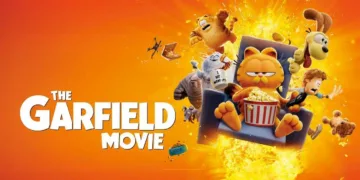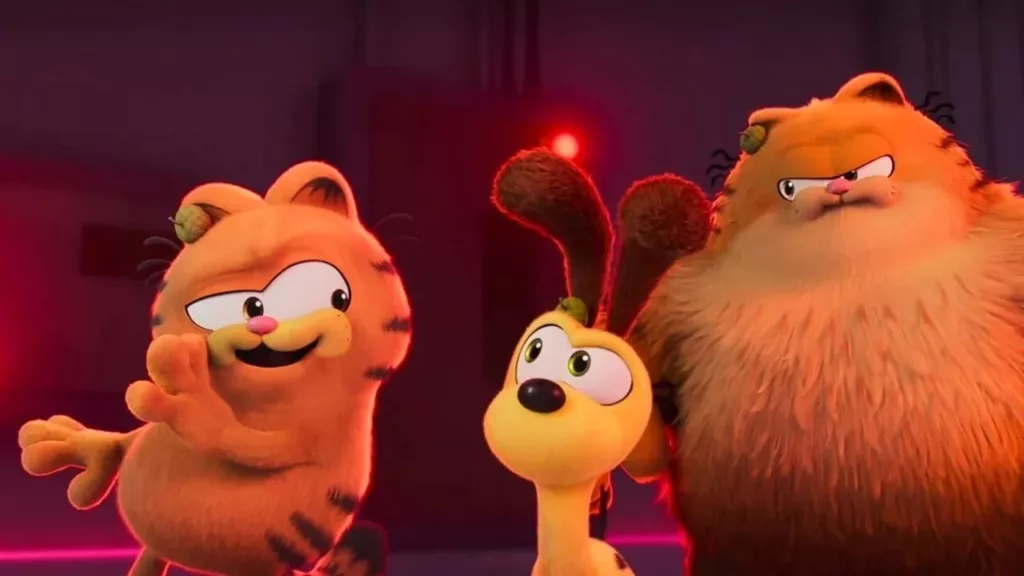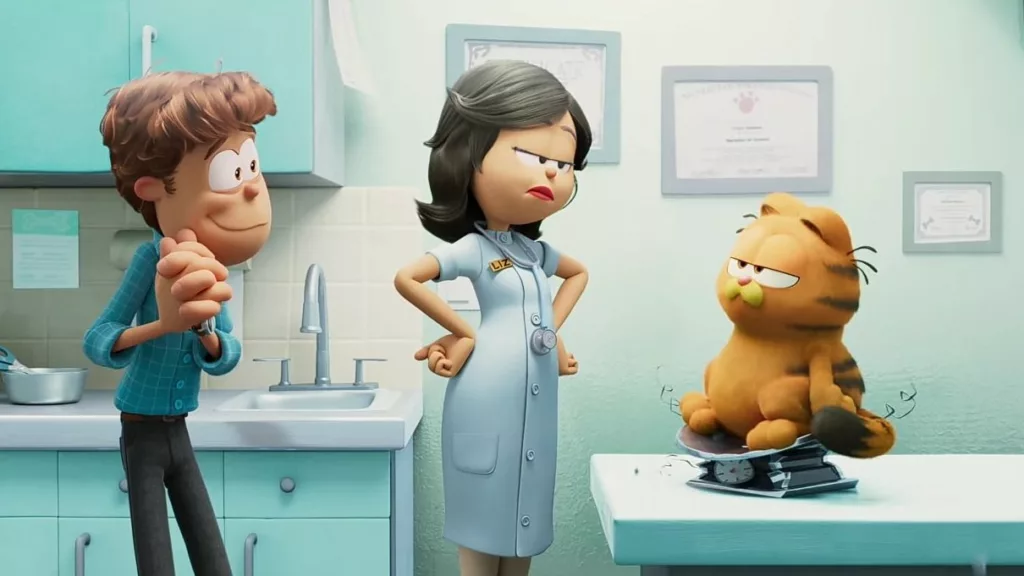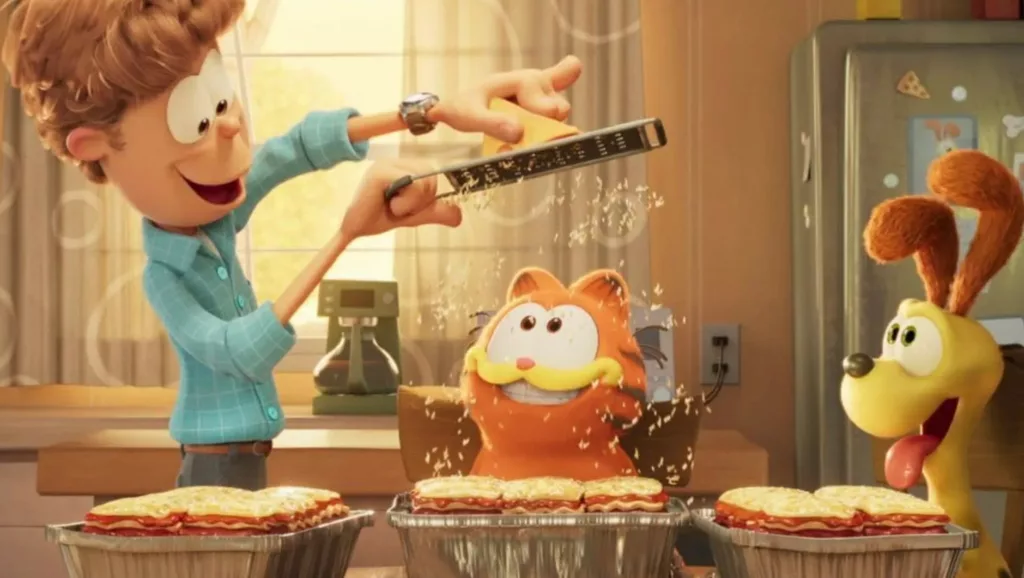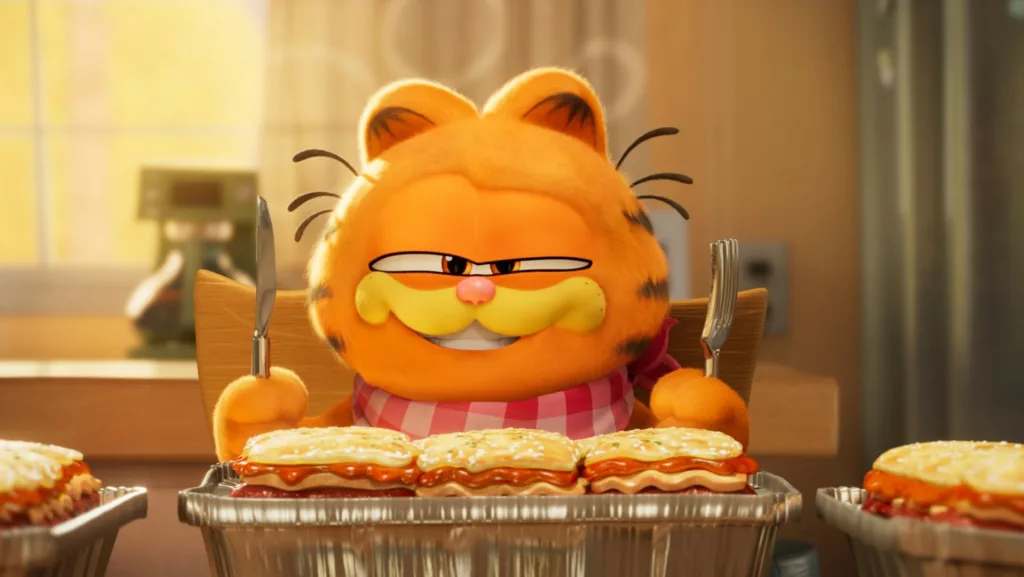With his sardonic humor and lazy lifestyle, Garfield has been putting a smile on faces since 1978. Jim Davis’ comic strips, featuring the orange tabby and his exasperated owner Jon, have appeared in thousands of newspapers worldwide ever since. Garfield’s grumpy wit connected with readers, cementing him as one of the most widely syndicated comic characters ever. His shenanigans and love of lasagna became ingrained in popular culture.
After so much success on the comics page, fans naturally wanted to see if Garfield could translate his charm to other formats. Television specials and shows brought the cat to animated life throughout the 80s and 90s. But it was about time for a big-screen venture to really let his personality shine in a new way. This movie seeks to do just that, finally giving us a fully animated movie to enjoy the cantankerous feline on an epic scale.
While keeping his essence intact, director Mark Dindal and the creative team seek to take Garfield’s world and cast of characters on a fun adventure that spans an entire film. After so many years of bringing smiles to the funny pages, this feature provides an exciting new way to experience everyone’s favorite lazy cat.
Contrived Capers Compromise a Cat’s Character
The Garfield Movie introduces a new backstory by having the lasagna-loving cat orphaned as a kitten and taken in by Jon. Yet much of its plot centers around fulfilling a debt through a bizarre heist. We learn Garfield’s father Vic abandoned him, and Vic remains in debt to the villainous cat Jinx after a failed robbery attempt.
To repay, Garfield and Odie are kidnapped alongside Vic. They’re forced to help steal over 1,000 gallons of milk from a dairy farm by the name of Lactose Farms. It’s here that other new characters are introduced, but few leave an impression. We meet Otto, a bull ousted from the farm and pining for his cow love, Ethel. Though Ving Rhames gives Otto some personality, the farmers receive little development as most focus shifts to the heist antics.
Chiefly, the heist scenes sideline what makes Garfield memorable: his laziness and disdain for effort. Pratt voices Garfield with boundless energy, eagerly participating in hijinks that would never interest the indifferent tabby of the comic strips. Even Odie is more proactively involved instead of being the brunt of Garfield’s pranks.
Perhaps most puzzling is how little the film utilizes Jon. Nicholas Hoult is largely wasted in a role that could have lent emotional stakes. Jon and Garfield’s relationship gave heart to past adaptations, yet the farmer becomes an afterthought here. Adding to missed opportunities is failing to explore Vic and Garfield working through their backstory of abandonment in a meaningful way.
By deviating from what fans love about Garfield and weakly developing new characters, the complicated plot works against the potential heart these adaptations once had.
Voice Acting Lacks Garfield’s Essence
Chris Pratt brings energy to the role of Garfield but misses the character’s deadpan wit. Garfield finds humor in apathy, observing the world from a position of amused detachment. Pratt plays him with good-natured enthusiasm, robbing the character of subversive charm.
Not all the voice work comes up short. Ving Rhames injects welcome dryness as Otto the bull, finally giving laughs with perfect comedic timing. You can imagine his understated line deliveries lifting straight from the comic strip. Harvey Guillén also shines as the ever-eager pup Odie, matching canine zest with hints of question.
Sadly, leads get less care. Nicholas Hoult’s owner, Jon, fades to wallpaper with no quirks to call his own. Samuel L. Jackson sleepwalks through Father Vic, wasting talent on a thinly written part. These missed opportunities lessen engagement, as time better serves supporting players.
Visually, the animation preserves familiar figures and details, down to the tiny tassels on Odie’s collar. Fur ruffling realistically in the breeze adds life, even if the overall style lacks edge. Straightforward rendering respects the source yet lacks the imaginative flair of Rhames’ detours into layered illustration. Overall, visuals entertain but never transcend expectations. A more creative spirit could have better brought settings to life and accentuated humor in Garfield’s world.
A clever design grounded the adaptation, while voices and visuals occasionally lifted the material. But by failing to bottle the mischievous essence of a comic genius, this feature invites little revisiting of a long-loved character. Opportunities were there to celebrate legacy through artistry, but sadly, most went begging.
Garfield’s Wit Lost in Translation
The true essence of Garfield, as so cleverly depicted in Jim Davis’ comic strips, is his cynical yet good-natured wit. With only a few sparsely drawn panels, Davis was able to craft jokes and commentary that still resonate today through Garfield’s deadpan one-liners and lazy disdain for life’s minor irritations.
Transposing this into a feature-length format proved challenging for The Garfield Movie. Faced with filling 90 minutes, the writers packed the plot with convoluted heist antics that did little more than exhaust both feline and human viewers. Complex subplots involving a lovesick bull and abandonment issues for our orange hero fell flat without Davis’ deft comic touch.
More troublingly, several scenes crossed lines considering the film’s target family demographic. A prolonged joke about roadkill and references to couples getting intimate left some theatergoers shifting uncomfortably in their seats. Mark Dindal’s accomplished past works, like The Emperor’s New Groove, show he’s capable of far more clever visual gags and witty dialogue.
Where the film did try to channel Garfield’s voice, the humor felt dated. Cat videos and drone deliveries placed the lazy cat squarely in modern times but missed opportunities for timeless jokes. Pop culture references to Baywatch and other franchises now feel as stale as week-old pasta leftovers. Compared to the strips, which maintained humor through the decades via subtle facial expressions and situations over the punchline, the movie opted for quickly outdated, low-hanging fruit.
By moving too far from what made Garfield funny on the page and adapting his quiet irony for animated hijinks, The Garfield Movie left behind the very spirit fans adored. With the tighter writing that sparked Garfield’s clever inner monologue, this translation could have been less frenetic and more true to its iconic source. As is, it serves only as a missed lasagna-filled opportunity to capture cinematic comedy as skillfully as Jim Davis did in four clever panels.
Garfield’s Got the Brands
Throughout The Garfield Movie, you can’t help but notice a near-constant barrage of product placement and pop culture references. Whether it’s Garfield casually ordering lasagna through a delivery app or grooving to the Top Gun theme, it’s hard to ignore the commercial motives at play.
It feels like every scene exists more to shill a brand than capture the spirit of our favorite lasagna-loving cat. We see Garfield unwinding with CATFLIX, just like us, though the streaming service exclusively features cat videos. His FedEx delivery arrives neatly packaged and on time, as advertised. There’s even a bizarre extended bit about roadkill that serves no comedic purpose.
You have to wonder if the filmmakers even bothered to read a Garfield comic. The strip was always clever in its simplicity, focusing on the timeless themes of laziness and aversion to Mondays that everyone can relate to. It didn’t need to panderingly reference the latest movies or constantly plug corporations.
Compare this to past adaptations that managed to bring the character to life without losing sight of what made him special. The live-action films of over a decade ago understood Garfield’s voice, even if the CGI wasn’t quite there yet. Animated shows and specials affectionately captured both his lethargy and sarcasm.
It’s like the studio couldn’t decide on an audience and instead opted for the lowest common denominator. But in chasing mass commercial appeal, they totally missed what makes Garfield, well, Garfield. This cat deserves an outing that respects both his legacy and the intelligence of his many fans, both old and new.
The Essence Got Lost in Translation
While the movie aims to entertain children, it misunderstands what makes Garfield unique. The nonlinear plot lacks focus, prioritizing action over character. We see Garfield kidnapped and forced into a convoluted heist, hardly reflecting his lazy nature. Gone are the dry wit and subtle comedy of his comic strips.
Surprisingly, even the live-action films from over a decade ago captured Garfield’s essence better. They set unrealistic situations around him but kept his cynical, self-centered spirit intact. In contrast, this version presents a very different character. Pratt’s performance isn’t the problem; it’s that the screenplay asks us to accept a hyper-Garfield far outside his comfort zone.
The movie also does Jon and Odie a disservice. In the comics, Jon’s frustration with Garfield is part of the fun. Here, he exists only as a prop. And while Odie remains loyal, the dynamic is altered from simple dog/cat rivalry to forced buddy cop antics. Remarkably, the movie sidelines two pillars of the classic stories in favor of an unrelated adventure.
Watching with kids, they laugh at the slapstick and bright colors. But this superficial enjoyment doesn’t warrant repeat viewings from older fans. Those nostalgic for Davis’ creation will find little reward. It fails to meaningfully build on a multi-generational legacy or craft new stories respecting what came before. Instead, it settles for fleeting interest by becoming just another forgettable family flick lacking staying power or rewatch value.
While animation allowed for new artistic visions of familiar characters in the past, this movie demonstrates how the essence can get lost when commercial priorities overwhelm faithful translation. For devotees of slow Sunday funnies, the experience gets lost in translation to a breakneck big screen outing as forgettable as any other.
The Orange Tabby Deserves Better
While efforts were made to recreate Garfield’s visual appeal, fundamental misunderstandings undermined The Garfield Movie. By discarding the essence of an iconic character, the film pursues fleeting box office over enduring entertainment.
Jim Davis crafted Garfield as a lazy yet likable cat, loving lasagna and loathing Mondays. His dry wit and ambivalence made lazi laughter easy. Yet this movie strips away such nuance, removing what has drawn readers since 1976. Beyond brief montages, little captures Garfield’s spirit. He abandons cynicism for excitement, filling a plot better suited to other properties.
Meaningful touches honor lore, like nods to Lorenzo Music and “Garfield and Friends.” But such references feel hollow when core traits change. A cat rejecting sloth for stunts leaves an unconvincing imposter where Garfield belonged. Readers know his appeal lies in disinterest, not grand adventure. By prioritizing spectacle over specificity, the film misses opportunities to showcase an iconic character.
While animation brings the tabby to life, hollow hijinks haunt what could have been. A truer take on respecting source strengths seemed overdue for the orange vagabond. With patience and understanding of what endeared millions, his cinematic return might have satisfied both young and old fans. As is, temporary fun comes at the cost of honoring the past and character, which many came to love. The mischievous moggy deserves fresh interpretation, bringing him back to an enchanting, engaging effect.
The Review
The Garfield Movie
The Garfield Movie offers fleeting fun yet squanders a chance for enrichment. By abandoning the essence of its iconoclastic character, it substitutes empty excitement for thoughtful entertainment. While nods to lore exist, the film fails to understand what drew generations to the lazy tabby. With patience and care for source strengths, his cinematic return could have resonated more deeply.
PROS
- The animation captures Garfield's visual design well.
- Voice actors like Guillén and Rhames provide some humor.
- Nods to Garfield's appreciation among fans
CONS
- Stripping of Garfield's core traits that made him iconic
- A compelling plot fails to understand character appeal.
- Wastes potential for thoughtful adaptation of rich source material
- Prioritizes spectacle over staying true to the spirit of strips
